Edible Slime
Slime is a staple of Halloween, chemistry, and science, in general. What could be better than stretching a glob of goo between your hands or […]
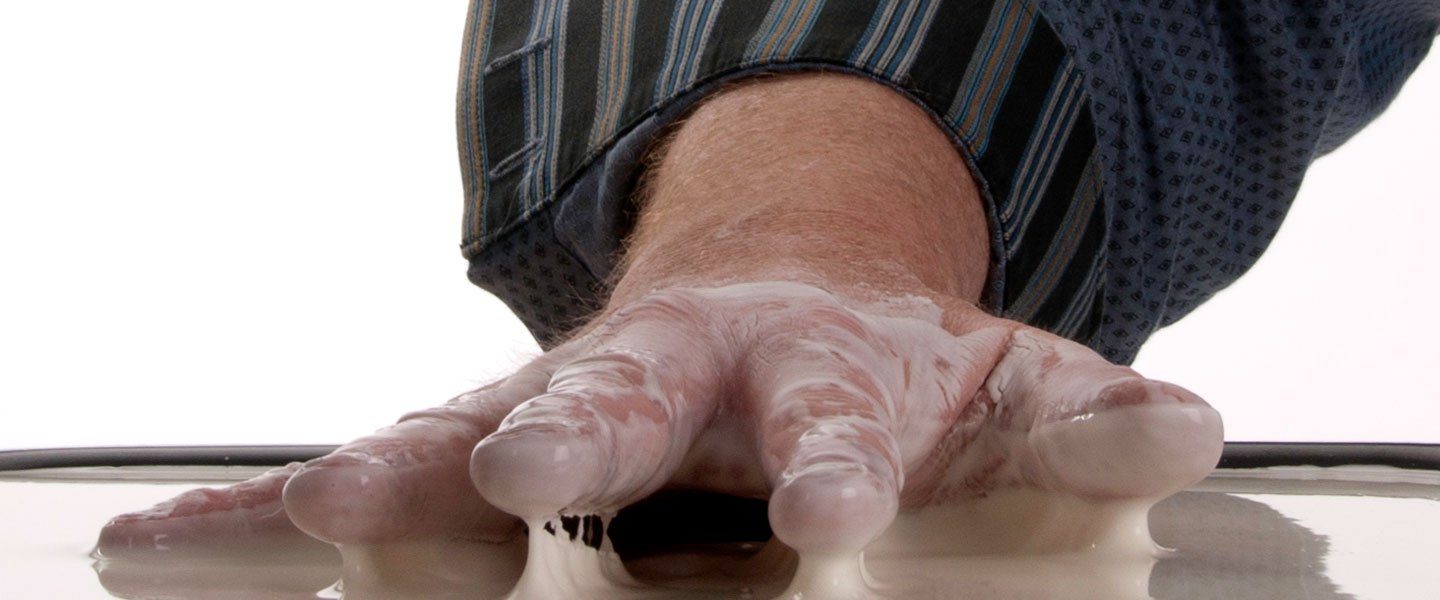
Anyone who has ever watched a classic Western knows about the dangers of quicksand. You know, that gooey stuff that grabs a hold of its victim and swallows him alive? So, what is quicksand and how does it really work? In this experiment, you’ll use ordinary cornstarch to model the behavior of real quicksand.
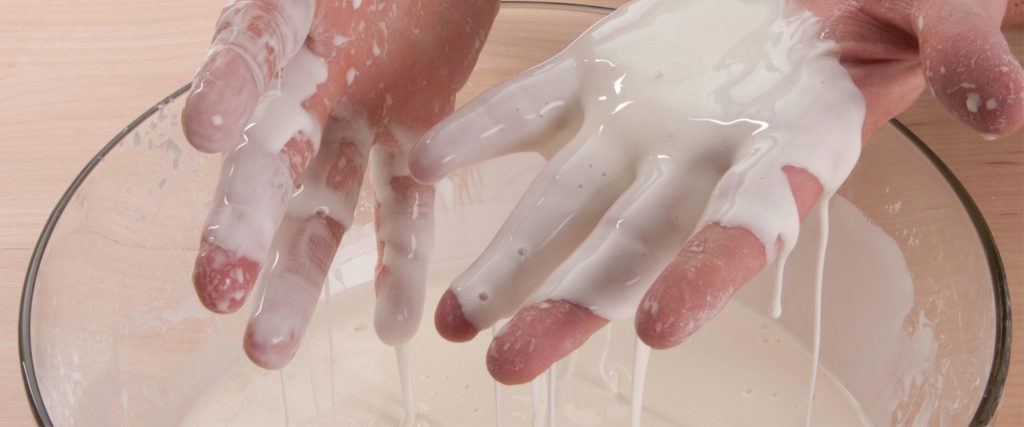
Pour approximately one-quarter of the box (about 4 ounces) of cornstarch into the mixing bowl and slowly add about 1/2 cup of water. Stir. Sometimes it is easier (and more fun!) to mix the cornstarch and water with your bare hands.
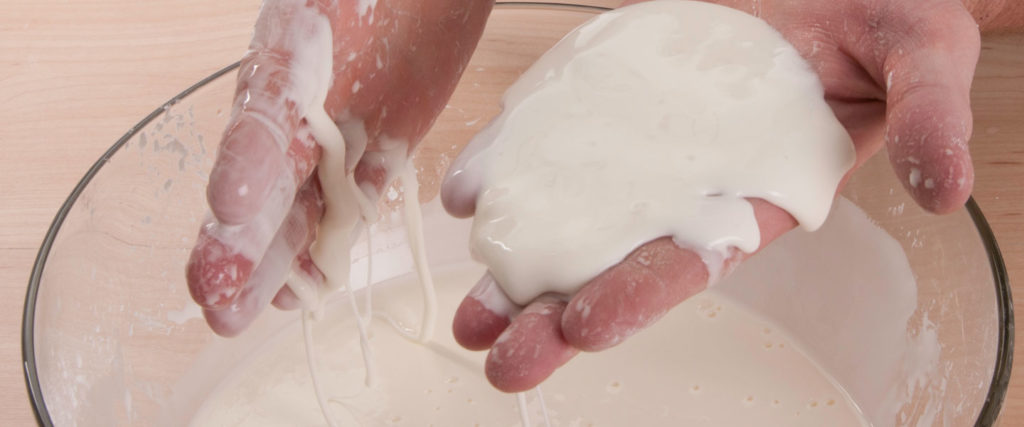
Continue adding cornstarch and water in small amounts until you get a mixture that has the consistency of honey. It may take a little work to get the consistency just right, but you will eventually end up mixing one box of cornstarch with roughly 1 to 2 cups of water. As a general rule of thumb, you’re looking for a mixture of roughly ten parts cornstarch to one part water. Notice that the mixture gets thicker, or more viscous, as you add more cornstarch.
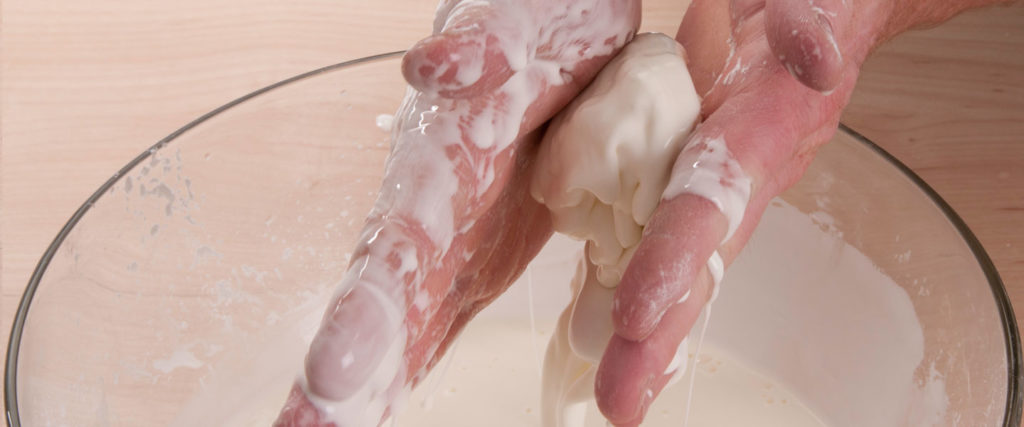
Sink your hand into the bowl of “quicksand” and notice its unusual consistency. Compare what it feels like to move your hand around slowly and then very quickly. You can’t move your hand around very fast. In fact, the faster you thrash around, the more like a solid the gooey stuff becomes. Sink your entire hand into the goo and try to grab the fluid and pull it up. That’s the sensation of sinking in quicksand!
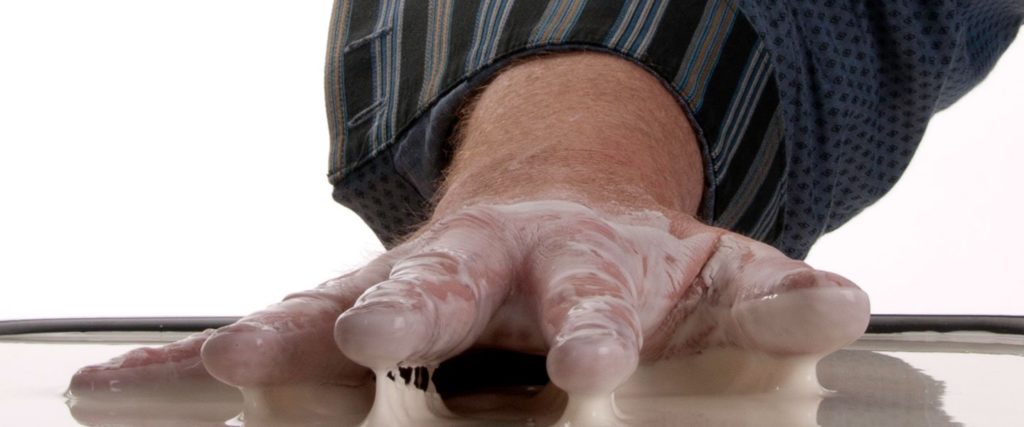
Drop a plastic toy animal into the cornstarch mixture and then try to get it out. It’s pretty tough even for an experienced quicksand mixologist.
The cornstarch and water mixture acts like a solid sometimes and a liquid at other times. This concoction is an example of a suspension (a mixture of two substances), one of which is finely divided and dispersed in the other. In the case of the cornstarch quicksand, it’s a solid dispersed in a liquid.
When you slap the cornstarch quicksand, you force the long starch molecules closer together. The impact of this force traps the water between the starch chains to form a semirigid structure. When the pressure is released, the corn- starch flows again.
All fluids have a property known as viscosity—the measurable thickness or resistance to flow in a fluid. Honey and ketchup are liquids that have a high resistance to flow, or a high viscosity. Water has a low viscosity. Sir Isaac Newton said that viscosity is a function of temperature. So, if you heat honey, the viscosity is less than that of cold honey. The cornstarch-water mixture, and real quicksand, are both examples of non-Newtonian fluids because their viscosity changes when stress or a force is applied, not when heat is applied.
What is quicksand, really? Quicksand is nothing more than a soupy mixture of sand and water, where the sand is literally floating on water. Quicksand is just solid ground that has been liquefied by too much water, and the term “quick” refers to how easily the sand shifts in this solid-liquid state. Quicksand is created when water floods or saturates an area of loose sand and the sand begins to move around. When the water in the sandy soil cannot escape, it creates a liquid-like soil that can no longer support any weight. If an excessive amount of water flows through the sand, it forces the sand particles apart. This separation of particles causes the ground to loosen, and any weight placed on the sand will begin to sink through it.
The quicksand phenomenon can be caused by flowing underground water rising to the surface or even an earthquake that agitates the sand. You are likely to find quicksand around riverbanks, lake shorelines, marshes, beaches, near underground springs or any place where an uprising of water oversaturates and agitates the sand.
The next time you are standing barefoot on the beach, think about the properties of quicksand. Normally, the grains of wet sand are compressed together tightly and this firm ground easily supports your weight. The friction between grains of wet sand is strong enough to make it easy to build sand castles. However, when the sand on the beach is flooded with an excess amount of water, the agitated sand particles begin to move, separate, and quickly wash away right out from under your feet.
Pour the mixture onto the cookie sheet or cake pan. Notice its unusual consistency when you are pouring it onto the pan. Stir it around with your finger, first slowly and then as fast as you can. Skim your finger across the top of the glop. What do you notice?
Try to roll the fluid between your palms to make a ball. You can even hold your hand flat over the top of the pan and slap the liquid glop as hard as you can. Most people will run for cover as you get ready to slap the liquid, fearing that it will splash everywhere.
According to theory, the mixture should stay in the pan. Yeah, right! If your cornstarch-water mixture inadvertently splatters everywhere, you will know to add more cornstarch. When you are finished, pour the glop into a large zipper-lock bag for later use.
The cornstarch will not stay mixed with the water indefinitely. Over time, the grains of cornstarch will separate from the water and form a solid clump at the bottom of the plastic storage bag. It is for this reason that you must not pour this mixture down the drain. It will clog the pipes and stop up the drain. Pour the mixture into a zipper-lock bag and dispose of it in the garbage.
In an effort to live out our mission (“Make It Big, Do It Right, Give It Class!”), we took this experiment to a whole new level on national television in February 2008.
When we originally discussed the idea of mixing up a batch of cornstarch and water with the producers of The Ellen Show, there was little interest—because they thought it was just a little tabletop experiment. When we shared the bigger idea of mixing up a batch of cornstarch goo big enough to fill a giant tub and inviting Ellen to walk across the surface without sinking, the producers gave us the green light.
The challenge was to turn this kitchen chemistry activity into a large-scale demonstration. Rather than buying one box of cornstarch, we were going to need 2,500 boxes of cornstarch. Anyone who has ever played with this cornstarch and water mixture knows that the bigger the batch gets, the harder it is to mix.
If Ellen or someone else was going to walk on water, my team and I would have to find a way to mix up a huge batch. That’s when my team of mixologists pitched the idea to the Bonanza Concrete company in Burbank, California. If 1 pound of cornstarch in a mixing bowl is fun, 2,500 pounds in a cement truck should be a blast.
Our goal was to mix up a batch large enough to fill a giant bathtub and then to attempt a quick run across the surface. The weight of someone’s body should cause the liquid to turn into a solid for a split second, allowing the person to literally run across the surface. Well, that’s the theory anyway.
Let’s start with the giant bathtub. The props guys on The Ellen Show (a very creative and talented team of people who can pull off anything) constructed a container 7 feet long, 3 feet wide, and 11⁄2 feet deep that held about 240 gallons of water. After mixing up several test batches, we discovered that the mixing ratio of ten parts cornstarch to one part water worked beautifully. Given the size of the tub, we would need roughly 2,400 pounds of cornstarch to mix with the 240 gallons of water.
Maybe it’s best to use pictures to explain the next part of the story . . .
Since our original stunt aired in February 2008, the Bonanza Concrete company has mixed up five more batches of cornstarch goo for game shows, educa- tional programs, and even a competition on a reality TV show. Back to our motto . . . “Make It Big, Do It Right, Give It Class.” Classy? Maybe not, but it sure made an impression!
According to The Worst-Case Scenario Survival Handbook, escaping from quicksand is easier than you might think. Stepping into quicksand is like stepping in a pond of goo. Your weight causes you to sink. A person’s natural instinct is to thrash around in an attempt to get out. In fact, this is the worst thing you could do because you only succeed in forcing yourself down farther in the quicksand pit. The best thing to do is to move slowly to bring yourself to the surface, lie back, and try to float on your back. According to the experts, you’ll be able to use your arms to slowly paddle to safety.